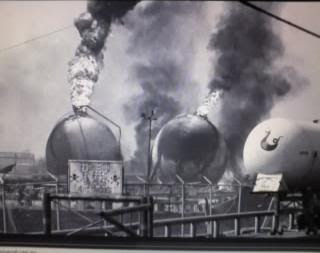
Hell On Earth: On Nov 19, 1984 a Pemex plant exploded killing nearly 600 people.
San Juan Ixhuatepec is a suburb of Mexico City, north of the capital just past the Periferico beltway. Middle class homes mixed among brick and tin shacks of low income families, living in the shadow of the huge Petroleos Mexicanos LP Gas Storage Facility. 6 Huge Spherical tanks holding thousands of liters of pressurized Liquid Petroleum gas loom in the horizon. Next to the huge spheres is a cylindrical tank farm holding even more gas. Next to the PEMEX installations is the Unigas Gas Distribution Center. 12 Gas Storage Facilities dominate the area of "San Juanico", including Gasomatico, Unigas and Gas Vela.
Since 3 AM on the morning of November 19th, 1984, there was a leak in an 8 inch pipe leading to one of the Pemex spherical tanks. The tanks had been nearly empty a day before and were now being refueled via pipeline from the Tula, Hidalgo oil refinery. For almost three hours, the gas cloud lingered throughout the facility.
Even some people living near the plant awoke from their sleep due to the strong smell of gas. At 5:40 am, the gas cloud reached a point of ignition, a spark from a delivery truck or a flare at the plant, the source of what was to happen to this day is unknown. What is known is, that the gas cloud reached a point of ignition, causing a blast and fire that destroyed 10 homes.
Even some people living near the plant awoke from their sleep due to the strong smell of gas. At 5:40 am, the gas cloud reached a point of ignition, a spark from a delivery truck or a flare at the plant, the source of what was to happen to this day is unknown. What is known is, that the gas cloud reached a point of ignition, causing a blast and fire that destroyed 10 homes.
6 minutes later, at 5:46 am, a raging hell was unleashed on San Juan Ixhuatepec.
The fire from the first minor blast reached 4 of the 6 spherical tanks,which were filled to 75 percent capacity, all four exploding almost at once in one huge catastrophic BLEVE blast. The tremendous blast was recorded on Mexico City seismographs and the huge mushroom cloud of fire reached 500 meters into the dawn sky.
The monster of fire devoured everything around the plant, instantly incinerating homes, people still asleep in bed, pets, livestock and vehicles. 5 city blocks were virtually razed by the hellfire and people, sleeping in their beds still on getting ready to go to work or school, were practically vaporized by the furnace like heat and fire. The fires and explosions also spread to the Unigas and Gasomatico plant, spurring more explosions.
The monster of fire devoured everything around the plant, instantly incinerating homes, people still asleep in bed, pets, livestock and vehicles. 5 city blocks were virtually razed by the hellfire and people, sleeping in their beds still on getting ready to go to work or school, were practically vaporized by the furnace like heat and fire. The fires and explosions also spread to the Unigas and Gasomatico plant, spurring more explosions.
After the 12 huge blasts that followed, the survivors of San Juanico were assaulted by a wave of heat and light. As if the sun had fallen on San Juan Ixhuatepec. Naked people or others, simply in their underwear and pajamas ran throughout the shattered glass and debris that littered the streets.
The blasts and fire seemed to come from everywhere. Flaming droplets of liquid petroleum gas rained upon the fleeing survivors causing horrendous burns. People on fire ran throughout the neighborhood, the oxygen fanning their flames until some, reaching the nearby Los Remedios river, threw themselves into the dirty waters to douse the fire that ate at their flesh.
 The bodies of one family of many who were killed in the blasts and fire litter the ruins of their home.
The bodies of one family of many who were killed in the blasts and fire litter the ruins of their home.Charred bodies littered the street. Burned survivors, dazed and in shock wandered throughout the street, the acrid smell of burned hair and flesh hanging over the town. The huge roar of the LP gas burning could be heard miles away. The huge flames at the plant, reaching 500 meters, could be seen from miles away in central Mexico City.
The curious inhabitants of the capital wondered what was happening behind the hills of Tlanepantla, marveling at the yellow/orange glow behind the hills. Many wondered if a warehouse was burning, or the Tula oil pipeline had perhaps caught fire, nobody knew. What was happening was a huge disaster that forever changed the lives of thousands.
At 6 am, the first fire trucks arrived into San Juan Ixhuatepec, ready to battle the huge conflagration. Shortly after all access into San Juanico was cut, causing huge traffic jams. Only ambulances, paramedics and firefighters were allowed into the ruined town that now resembled World War II Dresden. The first reporters to the scene covered their noses as the horrendous stench of burned bodies blew with the wind. The roar of the fire and more explosions could be heard. 30 ton steel Gas tanks flew through the air like rockets, one falling miles away and crushing a 2 story home, killing those inside.
 Dazed burned survivors sit on the sidewalks of San Juanico after the infernal blasts
Dazed burned survivors sit on the sidewalks of San Juanico after the infernal blastsAfter hours of firefighters battling the blazes, the toll was staggering. At least 503 people were dead most reduced to charcoal or scorched bones. At least 600 more were reported missing. More than 900 were injured, 60,000 were made homeless, most of the homeless and injured were housed temporarily at the Basilica of Our Lady of Guadalupe in Mexico City, a famous shrine. The charred bodies, mostly just unrecognizable piles of charcoal were placed in plastic bags and taken to a huge warehouse for Identification. Most of them were burned beyond recognition, impossible to tell their sexes much less who they had been in life. The Mexican Army now patrolled the streets to prevent looting. Almost 100,000 people had been evacuated from the area on city buses and taken to shelters.
After the blasts, Mexican society demanded to know what had happened at San Juan Ixhuatepec. Pemex issued a statement blaming Unigas Co., who had a storage facility next to the Pemex plant. They said an explosion in a tanker truck unloading gas at the Unigas plant had produced the catastrophe. Evidence pointed to the disaster originating at the Pemex plant. Surviving workers at the Pemex plant said a gas leak had been detected but nothing could be done, it had been detected too late. The gas cloud would soon reach the plant's flare so most just ran for their lives uphill, away from the blast zone.
Petroleos Mexicanos, after admitting its fault, promised money and shelter to those affected by the blasts.
On November 20 and 21st, most of the bodies were buried in three mass graves. Priests holding buckets of holy water sprinkled the huge tranches that would hold the 300 plus bodies that were never identified.
A year later, in November 1986 President Miguel De La Madrid promised aid and new homes, food and clothing to the survivors. Most would need surgeries and therapy to help with their burns. All the promises were later forgotten. A "Polygon of Security" was designed in San Juan Ixhuatepec to prevent more dangerous businesses to establish in such a densely populated area. The Mexico City government promised to relocate and banish the gas plants from San Juanico.
To this day, November 2009, 6 Gas storage areas remain. Including the Pemex facility which was rebuilt as the Satelite Norte plant. New gas stations and flammable materials storage warehouses were built inside the so called "Polygon of Security" ignoring a 24 year old Presidential decree. 14 businesses are classified as "dangerous to the community" with 12 of them being at risk of an explosion.
Survivors are still waiting for the money and aid promised by Petroleos Mexicanos 25 years ago. They are forced to work however they can, or beg for money on corners, covering their burned faces and limbs in shame, others not caring and living their lives, knowing they survived one of the worlds worst industrial disasters, that according to some, probably killed more than 1,200 people.
According to a El Universal newspaper poll, only 30 percent of people ages 18-25 know what happened on November 19, 1984 in San Juanico.
After the blasts, as is common after disasters, inappropriate and morbid "jokes" were made up by Mexico City residents.
Question: "How can you fit 500 people from San Juanico inside a VW Bug?"
Answer: "You put them in the ashtray".

I wasn't aware of this other tragedy that happened to the citizens of Tlanepantla. just because I was too young to realize what was going
ReplyDeleteon, it would be nice to get more photographs...good one!
This tragedy is unknown for many Mexicans nowadays. I haven't seen photos about this before! they are scary and I guess most of this terrible evidence has been hidden or destroyed by our Corrupt Government.
ReplyDeleteThank you for sharing!
Ernest, there are lots of photographs from that day available online. They are horrible images of charred bodies of men women and children, even babies. For a long time the Government and state-owned Petroleos Mexicanos blamed the origin of the disaster on the Unigas Co. distribution center which was next to the PEMEX plant. After investigations, it was VERY OBVIOUS, the catastrophe originated at the PEMEX plant...Just like PEMEX tried to blame La Central Cooking Oil for the explosions in Guadalajara in 1992... shameful events but part of our history, nonetheless.
ReplyDeleteCame across your blog after reading Tom Clancy's Red Storm Rising where this incident is a throwaway line by one character. thanks for taking the time to put it all down. Very shameful actions, esp the not paying the money promised. Where are the activists for this horrible treatment of mexican citizens.
ReplyDeleteThank you so much for this incredible story. It's a great shame that most of our young people in Mexico don't know about this, as it is a great example of the horrors that big business and government can cause towards the people.
ReplyDelete